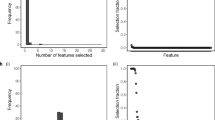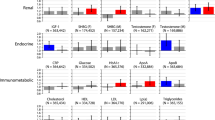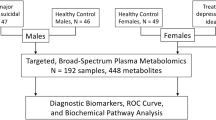Abstract
Despite decades of intensive research, the development of a diagnostic test for major depressive disorder (MDD) had proven to be a formidable and elusive task, with all individual marker-based approaches yielding insufficient sensitivity and specificity for clinical use. In the present work, we examined the diagnostic performance of a multi-assay, serum-based test in two independent samples of patients with MDD. Serum levels of nine biomarkers (alpha1 antitrypsin, apolipoprotein CIII, brain-derived neurotrophic factor, cortisol, epidermal growth factor, myeloperoxidase, prolactin, resistin and soluble tumor necrosis factor alpha receptor type II) in peripheral blood were measured in two samples of MDD patients, and one of the non-depressed control subjects. Biomarkers measured were agreed upon a priori, and were selected on the basis of previous exploratory analyses in separate patient/control samples. Individual assay values were combined mathematically to yield an MDDScore. A ‘positive’ test, (consistent with the presence of MDD) was defined as an MDDScore of 50 or greater. For the Pilot Study, 36 MDD patients were recruited along with 43 non-depressed subjects. In this sample, the test demonstrated a sensitivity and specificity of 91.7% and 81.3%, respectively, in differentiating between the two groups. The Replication Study involved 34 MDD subjects, and yielded nearly identical sensitivity and specificity (91.1% and 81%, respectively). The results of the present study suggest that this test can differentiate MDD subjects from non-depressed controls with adequate sensitivity and specificity. Further research is needed to confirm the performance of the test across various age and ethnic groups, and in different clinical settings.
This is a preview of subscription content, access via your institution
Access options
Subscribe to this journal
Receive 12 print issues and online access
$259.00 per year
only $21.58 per issue
Buy this article
- Purchase on Springer Link
- Instant access to full article PDF
Prices may be subject to local taxes which are calculated during checkout


Similar content being viewed by others
References
Pizzagalli DA . Frontocingulate dysfunction in depression: toward biomarkers of treatment response. Neuropsychopharmacology 2011; 36: 183–206.
Faraone SV, Tsuang MT . Measuring diagnostic accuracy in the absence of a ‘gold standard’. Am J Psychiatry 1994; 151: 650–657.
Ramirez Basco M, Bostic JQ, Davies D, Rush AJ, Witte B, Hendrickse W et al. Methods to improve diagnostic accuracy in a community mental health setting. Am J Psychiatry 2000; 157: 1599–1605.
Miller PR, Dasher R, Collins R, Griffiths P, Brown F . Inpatient diagnostic assessments: 1. Accuracy of structured vs unstructured interviews. Psychiatry Res 2001; 105: 255–264.
Miller PR . Inpatient diagnostic assessments: 2. Interrater reliability and outcomes of structured vs unstructured interviews. Psychiatry Res 2001; 105: 265–271.
Miller PR . Inpatient diagnostic assessments: 3. Causes and effects of diagnostic imprecision. Psychiatry Res 2002; 111: 191–197.
Quinones MP, Kaddurah-Daouk R . Metabolomics tools for identifying biomarkers for neuropsychiatric diseases. Neurobiol Dis 2009; 35: 165–176.
Schildkraut JJ . The catecholamine hypothesis of affective disorders: a review of supporting evidence. Am J Psychiatry 1965; 122: 509–522.
Schildkraut JJ . The catecholamine hypothesis of affective disorders: a review of supporting evidence. 1965. J Neuropsychiatry Clin Neurosci 1995; 7: 524–533.
Mooney JJ, Schatzberg AF, Cole JO, Samson JA, Waternaux C, Gerson B et al. Urinary 3-methoxy-4-hydroxyphenylglycol and the depression-type score as predictors of differential responses to antidepressants. J Clin Psychopharmacol 1991; 11: 339–343.
Delgado PL . Depression: the case for a monoamine deficiency. J Clin Psychiatry 2000; 61 (Suppl 6): 7–11.
Carroll BJ, Martin FI, Davies B . Pituitary-adrenal function in depression. Lancet 1968; 1: 1373–1374.
Carroll BJ, Curtis GC, Mendels J . Neuroendocrine regulation in depression. II. Discrimination of depressed from nondepressed patients. Arch Gen Psychiatry 1976; 33: 1051–1058.
Carroll BJ, Feinberg M, Greden JF, Haskett RF, Norman M, James NM et al. Diagnosis of endogenous depression. Comparison of clinical, research and neuroendocrine criteria. J Affect Disord 1980; 2: 177–194.
Carroll BJ, Feinberg M, Greden JF, Tarika J, Albala AA, Hasket RF et al. A specific laboratory test for the diagnosis of melancholia. Standardization, validation, and clinical utility. Arch Gen Psychiatry 1981; 38: 15–22.
Loosen PT, Prange Jr AJ . Serum thyrotropin response to thyrotropin-releasing hormone in psychiatric patients: a review. Am J Psychiatry 1982; 139: 405–416.
Loosen PT . The TRH-induced TSH response in psychiatric patients: a possible neuroendocrine marker. Psychoneuroendocrinology 1985; 10: 237–260.
Friess E, Schmid D, Modell S, Brunner H, Lauer CJ, Holsboer F et al. Dex/CRH-test response and sleep in depressed patients and healthy controls with and without vulnerability for affective disorders. J Psychiatr Res 2008; 42: 1154–1162.
Antonijevic I . HPA axis and sleep: identifying subtypes of major depression. Stress 2007; 11: 15–27.
Feinberg M, Carroll BJ . Biological markers for endogenous depression in series and parallel. Biol Psychiatry 1984; 19: 3–11.
Koyama T, Yamashita I . Biological markers of depression: who multi-center studies and future perspective. Prog Neuropsychopharmacol Biol Psychiatry 1992; 16: 791–796.
Steiger A, Kimura M . Wake and sleep EEG provide biomarkers in depression. J Psychiatr Res 2010; 44: 242–252.
Hashimoto K . Brain-derived neurotrophic factor as a biomarker for mood disorders: an historical overview and future directions. Psychiatry Clin Neurosci 2010; 64: 341–357.
Wong ML, Dong C, Maestre-Mesa J, Licinio J . Polymorphisms in inflammation-related genes are associated with susceptibility to major depression and antidepressant response. Mol Psychiatry 2008; 13: 800–812.
Licinio J, Wong ML . The role of inflammatory mediators in the biology of major depression: central nervous system cytokines modulate the biological substrate of depressive symptoms, regulate stress-responsive systems, and contribute to neurotoxicity and neuroprotection. Mol Psychiatry 1999; 4: 317–327.
Licinio J, Dong C, Wong ML . Novel sequence variations in the brain-derived neurotrophic factor gene and association with major depression and antidepressant treatment response. Arch Gen Psychiatry 2009; 66: 488–497.
Manji HK, Quiroz JA, Sporn J, Payne JL, Denicoff K, Gray NA et al. Enhancing neuronal plasticity and cellular resilience to develop novel, improved therapeutics for difficult-to-treat depression. Biol Psychiatry 2003; 53: 707–742.
Nestler EJ, Barrot M, DiLeone RJ, Eisch AJ, Gold SJ, Monteggia LM . Neurobiology of depression. Neuron 2002; 34: 13–25.
Savitz JB, Drevets WC . Imaging phenotypes of major depressive disorder: genetic correlates. Neuroscience 2009; 164: 300–330.
Hasler G, Drevsets WC, Manji HK, Charney DS . Discovering endophenotypes for major depression. Neuropsychopharmacology 2004; 29: 1765–1781.
Mossner R, Mikova O, Koutsilieri E et al. Consensus paper of the WFSBP task force on biological markers: biological markers in depression. World J Biol Psychiatry 2007; 8: 141–174.
Venter JC, Adams MD, Myers EW, Li PW, Mural RJ, Sutton GG et al. The sequence of the human genome. Science 2001; 291: 1304–1351.
Mitchell PB, Meiser B, Wilde A, Fullerton J, Donald J, Willhelm K et al. Predictive and diagnostic genetic testing in psychiatry. Psychiatr Clin North Am 2010; 33: 225–243.
Manolio TA, Collins FS, Cox NJ, Goldstein DB, Hindorff LA, Hunter DJ et al. Finding the missing heritability of complex diseases. Nature 2009; 461: 747–753.
Eichler EE, Flint J, Gibson G, Kong A, Leal SM, Moore JH et al. Missing heritability and strategies for finding the underlying causes of complex disease. Nat Rev Genet 2010; 11: 446–450.
Collier DA, Stober G, Li T, Heils A, Catalano M, Di Bella D et al. A novel functional polymorphism within the promoter of the serotonin transporter gene: possible role in susceptibility to affective disorders. Mol Psychiatry 1996; 1: 453–460.
Battersby S, Ogilvie AD, Smith CA, Blackwood DH, Muir WJ, Quinn JP et al. Structure of a variable number tandem repeat of the serotonin transporter gene and association with affective disorder. Psychiatr Genet 1996; 6: 177–181.
Lesch KP . Gene-environment interaction and the genetics of depression. J Psychiatry Neurosci 2004; 29: 174–184.
Lohoff FW . Overview of the genetics of major depressive disorder. Curr Psychiatry Rep 2010; 12: 539–546.
Serretti A, Kato M, Kennedy JL . Pharmacogenetic studies in depression: a proposal for methodologic guidelines. Pharmacogenomics J 2008; 8: 90–100.
Drago A, De Ronchi D, Serretti A . Incomplete coverage of candidate genes: a poorly considered bias. Curr Genomics 2007; 8: 476–483.
Bilello J, Pi B, Smith KM, Renshaw PF . Discovery and validation of a biomarker panel to identify patients with major depressive disorder. (In submission).
Renshaw PF, Bilello JA, Smith K, Thurmond LM . Assessment of a Biomarker Panel for Major Depressive Disorder in a Community Based Study. 164th Annual Congress of the American Psychiatric Association: Honolulu, Hawaii, 2011.
American Psychiatric Association and American Psychiatric Association. Task Force on DSM-IV. 1994. Diagnostic and Statistical Manual of Mental Disorders: DSM-IV. American Psychiatric Association; Washington, D.C, pp xxvii.
Sheehan DV, Lecrubier Y, Harnett-Sheehan K, Janavs J, Weiller E, Herguets T et al. The Mini International Neuropsychiatric Interview (M.I.N.I.): the development and validation of a structured diagnostic psychiatric interview. J Clin Psychiatry 1998; 59 (suppl 20): 22–23.
Hamilton M . A rating scale for depression. J Neurol Neurosurg Psychiatry 1960; 23: 56–62.
First M, Spitzer R, Gibbon M . Structured Clinical Interview for DSM-IV Axis I Disorders - Patient Edition (SCID-I/P, Version 2.0). Biometrics Research Department, New York State Psychiatric Institute: New York, 1995.
Watson S, Gallagher P, Smith MS, Ferrier IN, Young AH . The dex/CRH test—is it better than the DST? Psychoneuroendocrinology 2006; 31: 889–894.
Maes M . Depression is an inflammatory disease, but cell-mediated immune activation is the key component of depression. Prog Neuropsychopharmacol Biol Psychiatry 2011; 5: 664–675.
Dinan TG . Inflammatory markers in depression. Curr Opin Psychiatry 2009; 22: 32–36.
Müller N, Schwarz MJ . A psychoneuroimmunological perspective to Emil Kraepelins dichotomy: schizophrenia and major depression as inflammatory CNS disorders. Eur Arch Psychiatry Clin Neurosci 2008; 258 (Suppl 2): 97–106.
Leonard BE . Inflammation, depression and dementia: are they connected? Neurochem Res 2007; 32: 1749–1756.
Holsboer F . The corticosteroid receptor hypothesis of depression. Neuropsychopharmacology 2000; 23: 477–501.
Duman RS, Monteggia LM . A neurotrophic model for stress-related mood disorders. Biol Psychiatry 2006; 59: 1116–1127.
Acknowledgements
These studies were funded by Ridge Diagnostics.
Author information
Authors and Affiliations
Corresponding author
Ethics declarations
Competing interests
George Papakostas: Dr Papakostas has served as a consultant for Abbott Laboratories, AstraZeneca PLC, Brainsway, Bristol-Myers Squibb Company, Cephalon, Eli Lilly, GlaxoSmithKline, Evotec AG, Inflabloc Pharmaceuticals, Jazz Pharmaceuticals, Otsuka Pharmaceuticals, PAMLAB LLC, Pfizer, Pierre Fabre Laboratories, Ridge Diagnostics (formerly known as Precision Human Biolaboratories), Shire Pharmaceuticals and Wyeth. He has received honoraria from Abbott Laboratories, Astra Zeneca PLC, Bristol-Myers Squibb Company, Brainsway, Cephalon, Eli Lilly, Evotec AG, GlaxoSmithKline, Inflabloc Pharmaceuticals, Jazz Pharmaceuticals, Lundbeck, Otsuka Pharmaceuticals, PAMLAB LLC, Pfizer, Pierre Fabre Laboratories, Ridge Diagnostics, Shire Pharmaceuticals, Titan Pharmaceuticals and Wyeth. He has received research support from Bristol-Myers Squibb Company, Forest Pharmaceuticals, the National Institute of Mental Health, PAMLAB LLC, Pfizer and Ridge Diagnostics (formerly known as Precision Human Biolaboratories). Finally, Dr Papakostas has served (in the past, but not currently) on the speaker's bureaus for Bristol-MyersSquibb Co and Pfizer.
Richard Shelton: Dr Shelton has received Grant/research support from Eli Lilly and Company; GlaxoSmithKline Pharmaceuticals; Janssen Pharmaceutica; Pfizer; Sanofi Pharmaceutica; Wyeth-Ayerst Laboratories; AstraZeneca Pharmaceutica; Ridge Diagnostics; and Abbott Laboratories. He has been a paid consultant to Pfizer; Ridge Diagnostics and Janssen Pharmaceutica. He has served on speaker's bureaus for Bristol-Myers Squibb Company; Eli Lilly and Company; Janssen Pharmaceutica; Pfizer; GlaxoSmithKline Pharmaceuticals; Solvay Pharmaceuticals; Wyeth-Ayerst Laboratories and Abbott Laboratories.
Gustavo Kinrys: Dr Kinrys has served as an Advisor and/or consultant to AstraZeneca, Cephalon, Forest Laboratories, Glaxo SmithKline, Pfizer, Sepracor, UCB Pharma and Wyeth-Ayerst. Dr Kinrys has received research support from AstraZeneca, Bristol Myers Squibb, Cephalon, Elan Pharmaceuticals, Eli Lilly, Forest Laboratories, Glaxo SmithKline, Janssen, Pfizer, Ridge Diagnostics, Sanofi-Aventis, Sepracor, UCB Pharma and Wyeth-Ayerst. Dr Kinrys has served on the speaker's bureaus of Glaxo SmithKline, Janssen, and Wyeth-Ayerst.
Michael Henry: Dr Henry has received consulting fees from Ridge Diagnostics and research support from Shire, Forest, Sunovion, Eli Lilly, Bracco Diagnostics, Pfizer, GlaxoSmithKline, NARSAD and Ridge Diagnostics.
Bo Pi: Dr Pi is an employee of and holds stock in Ridge Diagnostics. Dr Pi has received research funding from the National Science Foundation as well as the National Institute of Mental Health. Dr Pi holds several patents and has several patents pending involving the use of biomarkers in major depressive disorder.
Linda Thurmond: Dr Thurmond is an employee of and holds stock in Ridge Diagnostics. Dr Thurmond has received research funding from the National Science Foundation as well as the National Institute of Mental Health.
John Bilello: Dr Bilello is an employee of and holds stock in Ridge Diagnostics Inc. Dr Bilello also holds stock in GlaxoSmithKline. Dr Bilello has received research funding from the National Science Foundation as well as the National Institute of Mental Health. Dr Bilello holds several patents and has several patents pending involving the use of biomarkers in major depressive disorder.
The remaining authors do not declare any conflict of interest.
Additional information
Supplementary Information accompanies the paper on the Molecular Psychiatry website
Supplementary information
PowerPoint slides
Rights and permissions
About this article
Cite this article
Papakostas, G., Shelton, R., Kinrys, G. et al. Assessment of a multi-assay, serum-based biological diagnostic test for major depressive disorder: a Pilot and Replication Study. Mol Psychiatry 18, 332–339 (2013). https://doi.org/10.1038/mp.2011.166
Received:
Revised:
Accepted:
Published:
Issue Date:
DOI: https://doi.org/10.1038/mp.2011.166
Keywords
This article is cited by
-
Serum indoleamine 2, 3-dioxygenase and tryptophan-2, 3-dioxygenase: potential biomarkers for the diagnosis of major depressive disorder
Psychopharmacology (2024)
-
Gut dysbiosis in severe mental illness and chronic fatigue: a novel trans-diagnostic construct? A systematic review and meta-analysis
Molecular Psychiatry (2022)
-
No increase in inflammation in late-life major depression screened to exclude physical illness
Translational Psychiatry (2022)
-
Major Depressive Disorder: Advances in Neuroscience Research and Translational Applications
Neuroscience Bulletin (2021)
-
Cerebrospinal fluid proteome evaluation in major depressive disorder by mass spectrometry
BMC Psychiatry (2020)



